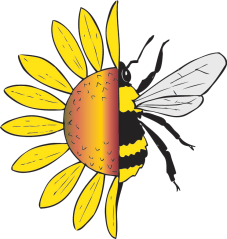Heralds of spring conjure pastoral images of baby lambs, daffodils, pussy willows and the return of robins. In the realm of bees one such herald probably goes un-noticed by most, the emergence of the unequal cellophane bee (Colletes inaequalis). In late March and early April their signature holes appear in open fields, lawns, pastures, meadows and even golf courses where vegetation is sparse. At first glance these bee holes look like ant hills but a closer look reveals a flurry of activity indicative of mating bees. There is not just one hole but hundreds that form a large communal aggregation of solitary bees. The female bees sit at their entrance holes as if guarding their nest chambers while male bees fly close to the ground patrolling the area in search of a mate. The males emerge earlier than the female bees and they have separate entrance holes where they return to at night to rest and sleep.
70% of native North American bees nest underground. The colletidae family is represented by nearly 100 North American species, a family overshadowed by the more populous Andrena mining bee, a family with over 400 species. Interestingly, scientists speculate that the ancestors of modern day colletes bees may once have nested in woody stems. Most ground nesting bees have a specialized structure at the tip of their abdomen called a pygidia plate with a brush of hairs around it that is used for sculpting the soil in underground tunnels. Colletes lack this tell-tale structure common among other ground nesting species, a body part not needed by stem nesting bees. The bees never re-evolved the pygidia plate when they took to nesting beneath the earth. In the same family, Hylaeus bees still nest in stems. There is little similarity between the two genus’ except that like their cousins they line their nests with a transparent cellophane like substance.
Colletes (one who glues) is truly a unique group of bees, sometimes called polyester, cellophane or plasterer bees, for the substance that lines their nesting chambers that makes them water proof! The bees use their short fork like tongues to paint the interior of their tunnels with this cellophane like material produced from secretions from the dufour’s gland and mixed with saliva. This bee produced material is strong, mold resistant and waterproof, protecting the developing larvae inside a natural plastic bag. The bees bio-derived plastic has inspired some scientists to study this substance as a natural alternative to plastic. The chemical riddles of bee biology presents challenging obstacles that if unraveled could inspire an eco-friendly solution to the worlds plastic problems.

In the Northeast, the unequal cellophane bee (Colletes inaequalis) is the first Collete to emerge in the spring. They are generalist pollinators visiting a variety of early spring blooming flowers like pussy willows, red maple and other early spring flowers. They bring the pollen back to provision their nest chambers with a “soup” like mixture. In the darkness of the underground chambers the eggs hatch and grow as they devour their liquid food source.
Shortly after the emergence of the unequal cellophane bees comes Rufous-backed cellophane bees (Colletes thoracicus). These bees emergence coincides with the blooming of the tulip poplar (Liriodendron tulipifera) flowers. Though they can be found feasting in the flowers high-up in these towering trees they also visit other flowering trees that bloom around the same time. They are not a true specialist but considered a generalist pollinator.

A true Colletes specialist emerges in mid-August, the broad footed cellophane bee (Colletes latitarsis) coincides with their host plants, Physaylis species, which include tomatillo and the ground cherry. Bees that visit plants in only one family are called oligogetic. Though they clearly prefer these flowers they have been seen supplementing pollen and nectar at other plants that bloom during the same time period. According to Specialist bees of the Mid-Atlantic and Northeaster United States by Sam Drouge and Jarrod Fowler there are at least 13 species of Colletes that specialize on certain plant families ranging from hollies to asters.
Resources:
Wilson, Joseph, S., Messinger Carril, Olivia. The Bees in our Backyard. A Guide to North American Bees. Princeton University Press. 2016. 96-108.
Eveleth, Rose. “Can Bees Make Tupperware, A materials scientist discusses Colletes bees, which line their homes with plastic.” Scientific American. 12/2011. https://www.scientificamerican.com/article/from-pollen-to-polyester/
Categories: Colletes, ground nesting bees, native bees






